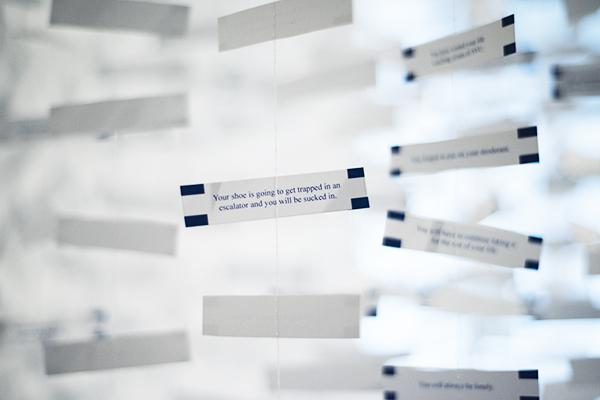Coming to the close of four years of their art education, 56 students in the AD 403 Senior Exhibition course showcase the culmination of the work they’ve composed during this semester in a collection at the DeVos Art Museum from April 19 to May 5.
Walking into the exhibit, members of the public are greeted by 13 various concentrations within the art department, including human-centered design, graphic communication, illustration, computer art, digital cinema, electronic imaging, furniture design, jewelry/ metals/ blacksmithing, photography, printmaking and sculpture.
 The overarching goal for these students is to examine “the way we function in the world and the way we interact with different things in the world,” said DeVos Art Museum Director and Curator Melissa Matuscak.
The overarching goal for these students is to examine “the way we function in the world and the way we interact with different things in the world,” said DeVos Art Museum Director and Curator Melissa Matuscak.
With the exception of art history, all art and design students in studio programs are required to take AD 403, which is a course designed to familiarize students with the process of displaying their work in a gallery. This learning process begins with the logistics of filling out gallery paperwork, figuring the insurance for the piece and, finally, how to execute the display.
Students need to ask themselves about installation and how their work looks in a public space, Matuscak said. Careful thought is put into how the mounted piece takes up space, which areas are lit and how the piece interacts with the audience.
The course has a deadline-driven nature and provides real-world simulation for an artist in the field, said current AD 403 student Trent Davis.
“AD 403 really forced me to beat myself into a work ethic,” Davis said.
The course instilled in Davis what he would have otherwise had to learn in the unforgiving, consequence-ridden field. The class changed how Davis thought about projects, evolving from working on projects for segmented amounts of time to eight-hour workdays—at the least.
Since students in the class come from a handful of majors and 13 various art concentrations, it all yields fresh eyes on the pieces. This collaborative environment is more effective than when all one’s peers are within the same concentration, Davis added.
The exhibition is a way for graduating seniors to come full circle and see the fruit of their semester-long efforts in their final physical form and on public display. This also offers students the chance at real-world application for future careers and to create a culmination of their most noteworthy pieces into an accessible portfolio, Matuscak said.
What’s unique about the student show is that the gallery is filled with pieces that were inspired by not one single concept, but by differing forces within the 13 art concentrations with everything from music videos to sculptures.
“There’s something for everyone in here,” Matuscak said.
This is what makes the Student Exhibition so compelling, she said. What is uniting about the varieties of inspiration, though, is the underlying desire to solve problems. Art does not have to illicit a positive response all the time. Art has a way of stirring up the dust inside of ourselves that may have otherwise lain dormant.
“Art can make you mad, it can cause you to want to take action about a problem,” Matuscak explained.
This exhibition is a multi-functional space—students display their work, employers scope out the incoming wave of artists, and it’s a space for the public to enjoy the works of NMU students.
“Local business owners come into the show who are looking for interns or future employees,” Matuscak said.
At the end of the exhibit at 8 p.m. on May 5, three out of the 56 students will be awarded a cash prize. The pieces most likely to be awarded are the “pieces you stop and stare at,” Davis added.
























